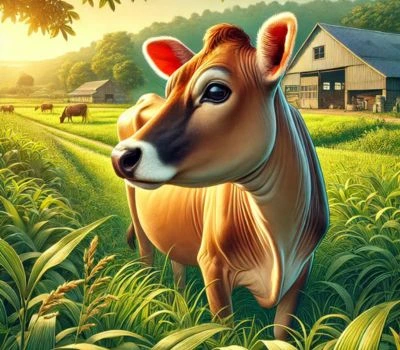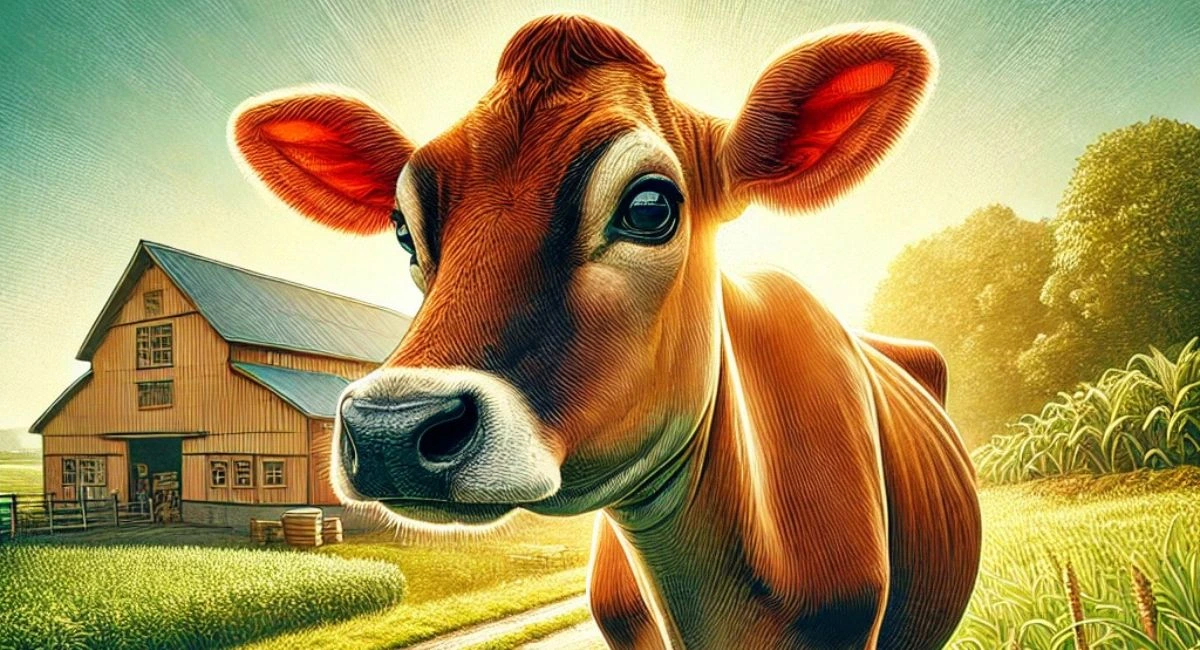The Jersey cow, widely recognized for its high-quality milk and adaptability, has become essential to Indian dairy farming. Originating from the Channel Island of Jersey, this breed offers numerous advantages for Indian farmers seeking both productivity and low maintenance.
Origin of Jersey Cows
Originally bred on the Island of Jersey, located off the coast of France, the Jersey cow has a long history of milk production. Through centuries of selective breeding, these cows developed a reputation for their ability to produce rich, high-butterfat milk in moderate climates.
They were introduced to India primarily for their adaptability to warmer temperatures and suitability for smaller farms with limited resources. Jersey cows have since gained immense popularity in India, where their compact size, high milk yield, and easy maintenance make them especially beneficial for small and medium-scale farmers.
Characteristics
Jersey cows are known for their compact size, high milk yield, and superior fat content, making them a preferred choice for dairy farming in India. They typically weigh between 400 to 500 kg, while Jersey bulls range from 540 to 820 kg.
The breed has a reddish fawn coat, sometimes with white patches, and is characterized by a dished forehead, compact, and angular body structure. These physical attributes contribute to their efficient feed conversion and adaptability to India’s varied climatic conditions.
Milk Yield and Fat Content
Jersey cows are highly economical milk producers, requiring less feed while delivering higher-quality milk. They produce an average of 15 to 25 liters per day, which totals around 4,500 kg per lactation.
Their milk fat content is approximately 4.5%, significantly higher than Holstein cows, which average 3.7%. This makes Jersey milk ideal for butter, ghee, and other dairy products that require rich, creamy milk.
Adaptability
Jersey cows are well-suited for Indian dairy farms, especially in states like Punjab (Hoshiarpur, Ropar, Gurdaspur) and other dairy-centric regions. They are known for their docile temperament, making them easy to manage, even on small-scale farms.
Their smaller body size reduces feeding costs, making them a cost-effective and sustainable choice for farmers looking for high milk efficiency with minimal maintenance.
Nutritional Benefits
One of the main reasons for the popularity of Jersey cows is the exceptional quality of their milk. Jersey milk is distinguished by its creamy texture, high butterfat content (typically between 4.5% and 5.5%), and rich nutritional profile.
It is particularly suitable for producing ghee, butter, and cheese – products that have a strong demand in India. Rich in essential nutrients, Jersey milk provides high levels of calcium, vitamin A, and vitamin D, supporting bone health and overall immunity.
Additionally, it contains A2 beta-casein protein, which many people find easier to digest compared to the A1 protein found in other cow breeds. This feature makes Jersey milk ideal for individuals with mild lactose sensitivities, enhancing its appeal among health-conscious consumers.
Benefits of Rearing Jersey Cows
For dairy farmers, especially those managing small or medium-sized operations, Jersey cows offer numerous economic advantages. Their relatively small size means they require less feed, helping farmers reduce costs while still achieving high milk yield.
A Jersey cow can produce around 15–20 liters of milk per day under optimal conditions, making it a reliable source of income for farmers. In addition to the lower feeding cost, the quality of Jersey milk commands a higher market demand, especially for products like curd, butter, and sweets.
This demand translates to higher returns, which can significantly benefit farmers looking to expand or stabilize their dairy businesses without incurring substantial extra costs.
Care and Maintenance

To maintain productivity and health, Jersey cows require appropriate care and management. They thrive best in clean, well-ventilated housing that protects them from extreme weather, minimizing stress and reducing the risk of diseases.
Although they require less feed compared to larger breeds, it is crucial to provide a balanced diet that includes green fodder, dry roughage, and minerals. Regular health checkups are essential to monitor and prevent common issues such as mastitis, an udder infection that can impact milk quality and yield.
Maintaining a clean environment, ensuring adequate water supply, and staying on top of veterinary care, farmers can keep Jersey cows healthy and productive over the long term.
Jersey Cows in Sustainable Agriculture
Jersey cows also support sustainable dairy farming practices. Their smaller size and lower feed requirements lead to reduced methane emissions compared to larger breeds, which is better for the environment.
Their adaptability to natural and organic farming techniques also makes them a favorable option for farmers aiming to reduce reliance on synthetic feeds and additives. In terms of land use, Jersey cows allow for efficient use of available agricultural resources.
Due to their lower feed consumption, farmers can manage more cows on smaller plots, maximizing productivity without increasing environmental impact. This balance between high-quality output and minimal environmental strain positions Jersey cows as a sustainable choice for dairy farming.
Government Support
Recognizing the benefits of Jersey cows, various government programs and agricultural institutions offer support to dairy farmers. Organizations such as the National Bank for Agriculture and Rural Development (NABARD) provide financial assistance and subsidies for farmers raising Jersey cows, which makes the breed more accessible to small-scale farmers.
Moreover, state and central governments offer incentives and training resources to promote the adoption of Jersey cows, further bolstering dairy farming productivity. Agricultural universities and dairy boards across India also provide workshops, training programs, and valuable resources on Jersey cow maintenance, helping farmers improve their practices and achieve better results.
In summary, Jersey cows have become an invaluable resource for Indian dairy farmers, providing a sustainable, profitable, and manageable solution for high-quality milk production. Their ability to produce nutrient-rich milk while requiring lower feed and maintenance costs makes them ideal for farmers looking to maximize profitability without compromising on quality.
Supported by government initiatives and institutions, Jersey cows offer both economic and environmental benefits, contributing to a thriving dairy industry in India. Through continuous farmer education and accessible support systems, Jersey cows are poised to play a significant role in advancing Indian dairy farming for years to come.

